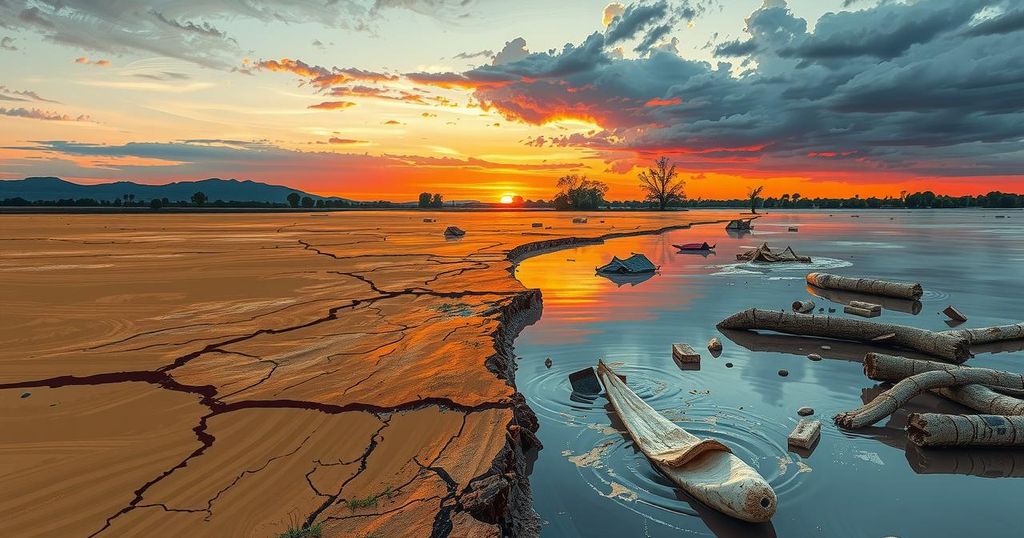Indigenous migrants in northern Colombia, particularly the Wayuu community, face severe consequences from climate change, including droughts and floods that lead to food insecurity and displacement. Many lack access to basic services and struggle for survival, while local leaders advocate for better support amid increasing environmental challenges. The difficulties brought on by climate change highlight the urgent need for intervention and sustainable solutions.
Indigenous migrants, particularly the Wayuu people, are facing severe impacts from climate change in northern Colombia’s La Guajira region. These challenges include worsening droughts and flooding, leading to food insecurity, displacement, and a significant strain on vital resources. Many Wayuu individuals, despite being born in Colombia, suffer due to the influx of those who have fled Venezuela, exacerbating their struggles for basic necessities.
Nelly Mengual, a 47-year-old resident of an informal settlement, recounts losing her home’s roof to flooding. She lives among thousands of other Wayuu, whose relationship with the land transcends political borders. Yet, they reside in areas lacking access to clean water and electricity, relying on recycling and other means to support their families amidst a deteriorating environment.
The Wayuu, Colombia’s largest Indigenous group, are increasingly facing the dual threats of extreme weather patterns driven by climate change. These changes not only damage homes but also deplete water sources, damage crops, and heighten the risk of diseases. Many families are compelled to migrate to urban areas in search of resources, which puts additional pressure on these already overcrowded regions.
Community leader Ingrid Gonzalez highlights the vulnerability of traditional Wayuu homes during the rainy season. These mud-based structures often collapse under heavy rains, endangering residents. She reports significant damage, noting that local infrastructure cannot withstand climate disturbances. Meanwhile, Corpoguajira’s Samuel Lanao informs that the relentless storms and subsequent flooding have heightened the prevalence of diseases such as dengue in the Indigenous communities.
Camilo Martinez, managing operations for the Danish Refugee Council, acknowledges the undeniable changes in La Guajira’s climate. His observations reveal a marked shift in weather patterns, impacting local living conditions and agricultural practices, making life increasingly difficult for the Wayuu.
The impact of extreme heat is another pressing challenge, as witnessed last year. Gonzalez remarks on the detrimental health effects the heat has on the population and their livestock. The lack of access to clean water further complicates living conditions, as residents resort to purchasing water from unreliable sources.
Various non-governmental organizations are stepping in to fill the gaps left by the state, which has failed to provide adequate support. Anibal Mercado, a Wayuu leader, expresses concerns about the government’s neglect and its adverse effects on the Wayuu’s traditional economy and sustenance practices.
In the Uyatpana neighborhood, the struggles of the Wayuu continue as individuals, like Laura Pushaina, strive to rebuild after their homes are repeatedly devastated by floods. Despite hopes of returning to their rancherias in Venezuela, many realize that conditions are too precarious for such a move. Pushaina’s recount of the floods illustrates the harsh realities many are facing, as they navigate the tumultuous consequences of climate change.
In conclusion, the Wayuu people in northern Colombia are experiencing the brunt of climate change, facing worsening droughts and floods that jeopardize their way of life. These environmental challenges have resulted in significant displacement, food insecurity, and health risks. The efforts of community leaders and NGOs strive to provide relief, yet the pervasive neglect by governmental authorities continues to aggravate their plight. As climate change intensifies, the urgency for sustainable solutions to support Indigenous communities like the Wayuu becomes paramount.
Original Source: www.independent.co.uk




